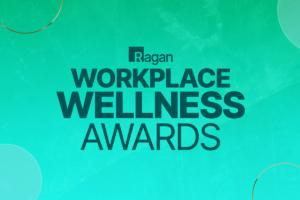Curating the week in wellness Feb. 21-25, 2022
Alternative compensation models to combat inflation, how to be a better listener and combatting biases against plus-size workers.

Hello, wellness pros!
This week included a palindrome date, 02-22-2022 (aka “Twosday”), which proved especially popular for weddings and various food deals. We are here today with a collection of thought-provoking articles, tips and takeaways for the week.
Please get in touch with any ideas, suggestions or feedback on how we can serve you better or cover topics that are top-of-mind at your organization. Email: kaceyl@ragan.com.
1. Updated performance review models and stock vesting options ways to combat higher pay amidst rising inflation.
The Great Resignation is perpetuating a cycle of inflation, according to reporting from CNN Business: “As more people look for new jobs while they are already employed, negotiated wages go up, according to the [Federal Reserve Bank of Chicago], which fuels wage inflation, and to some extent overall inflation.”
But if you are hiring and want to appeal to candidates or are trying to stay competitive to retain employees, how can raising wages not be part of the equation? CFO Dive explores how some companies are speeding up and/or increasing stock vesting offerings. A few examples:
- Amazon is reportedly speeding up its stock vesting, which would allow employees to access the value of their equity holdings much earlier. This follows the company’s previously announced base salary increase from $160,000 to $350,000.
- Apple introduced a new program that allows all employees to receive restricted stock units.
- Google is also reportedly taking similar steps to increase and front-load stock awards.
The trend of speeding up the timeline for compensation increases is not limited to that the tech industry. Industrial ceramics company CoorsTek Inc. shifted its performance reviews from annually to quarterly with the goal of , keeping existing employees rewarded to prevent them from feeling slighted if the company brings in new people at higher salary levels.
CFO Dive writes, “[T]he quarterly reviews also have another benefit: If market pressures soften and pay levels ease, the company can quickly adjust salary changes to reflect the new reality rather than wait for an annual review.”
2. Listening mistakes and how to learn from them.
Fast Company spoke to Michael Reddington, a forensic interviewer and president of InQuasive, about common listening mistakes and learning opportunities.
One mistake people often make is falling prey to their biases, which can occur in two ways. Reddington says that “people match their listening effort to the expectations they carry into the exchange,” which can cause information to be missed or dismissed. People may also find it difficult to not separate the messenger from the message itself, which can lead to missed learning opportunities during a conversation.
Distractions are another listening pitfall. Reddington also points to internal monologues and biases as distractions that can go overlooked. An internal monologue distraction can occure when someone is thinking about what to say next rather than focusing on what is being said, while a bias distraction can stem from only hearing information that confirms what is already believed and disregarding the rest.
The good newsis that remote working arrangements provide a great opportunity to work on listening skills. “Just focus on the verbal delivery, word choice, the speed and tone of voice, and pauses,” Reddington explains. “You should be much more in tune and do a much better job listening. As long as you can limit the distractions on your end, this should be an opportunity for improving your listening.”
3. Biases against plus-size workers.
Diversity, equity and inclusion (DE&I) conversations generally focus on race, gender and sexual orientation, but Employee Benefit News (EBN) raises the question of whether body types should be included in the discussions.
The reporting points to a few statistics:
- According to the Center for Disease Control and Prevention, 42.4% of the U.S. population in 2020 was categorized as overweight or obese.
- CareerBuilder reports that more than half that demographic are active in the workforce.
- A 2018 LinkedIn study found that half of employers are less likely to hire overweight workers than thinner prospects, and when they are hired, obese workers are paid roughly $2,500 less than thinner colleagues.
- The International Journal of Obesity reports that overweight or obese employees are often stereotyped as lazy, unmotivated and less competent than others.
In addition to perception biases and stereotypes, plus-size employees may also experience physical barriers. “Office furniture is often not accommodating to larger individuals, dress codes may be more strictly enforced, and even healthcare benefits and programs may be more limited when it comes to supporting the health of plus-size employees,” EBN writes.
The solution: Examine whether your organization demonstrates a pattern of pay discrepancies between employees with different physical appearances and abilities, check-in with employees about their comfort at work and consider expanding your definitions of diversity for further DE&I trainings and initiatives.
4. Clearly define flexible work—for employees’ mental health.
The Economic Times reports that employee wellness platform Nova Benefits, an India-based company, has rolled out an employee mental health wellness plan that commits to reimburse employees for any expenses incurred relating to mental health. Additionally, employees are required to take a break after every 45 days of continuous work.
That approach is supported by January Qualtrics survey wherein more than half of full-time U.S. workers said their job was the main source of their mental health challenges. Other takeaways from the survey are:
- 36% of respondents said the flexibility to work whenever and wherever would impact their mental health “positively.”
- 87% of employee respondents want to be in control of their schedules
- The survey found the definition of flexible work that employees desire is not always the same as 41% would prioritize choosing which hours they work, 25% would prioritize which days and 14% would prioritize location.
- However, more than half of respondents also indicated concern that taking advantage of flexibility options may hurt their pay or career advancement potential.
While flexibility alone cannot combat employee mental health concerns, having a clear definition of what flexibility means at your organization to destigmatize flexible work policies—or empowering managers to decide what flexibility for their teams—may be a good place to start.
5. Napping as an office perk.
As Google teases its return-to-office plans, Insider writes that the company is “reviving old perks like massages and fitness centers.” Pre-pandemic in-office employees had access to volleyball courts, gourmet food cafeterias, rock climbing and nap pods.
With more and more employers considering a return-to-office, a report from The Globe and Mail posits that more employers should consider adding nap pods to their offices toboost productivity. This may seem like an odd thing to encourage, but Dallas-based sleep expert James Maas says, “Not only does it help your immunity, but there is very clear evidence that is increases your cognitive processing, your cognitive thinking and your creative thinking.”
The story cites a Better Sleep Council survey that found one in five working adults take a workday nap. As this is especially appealing to Gen Z and millennial workers, sleep-friendly policies could be a perk to current and prospective employees.
COMMENT
Ragan.com Daily Headlines
RECOMMENDED READING
Tags: flexible hours, flexible work, inclusion, inflation, listening, mental health, obesity, Performance management, sleep quality






